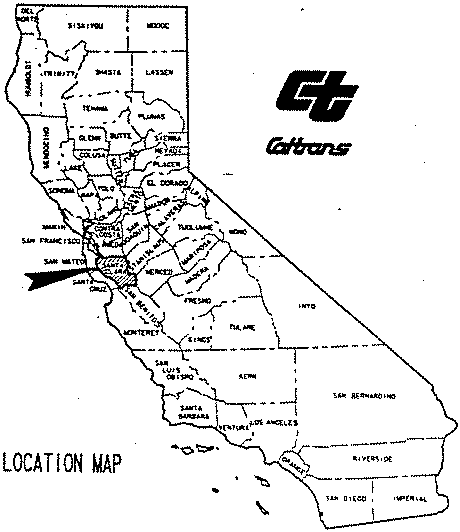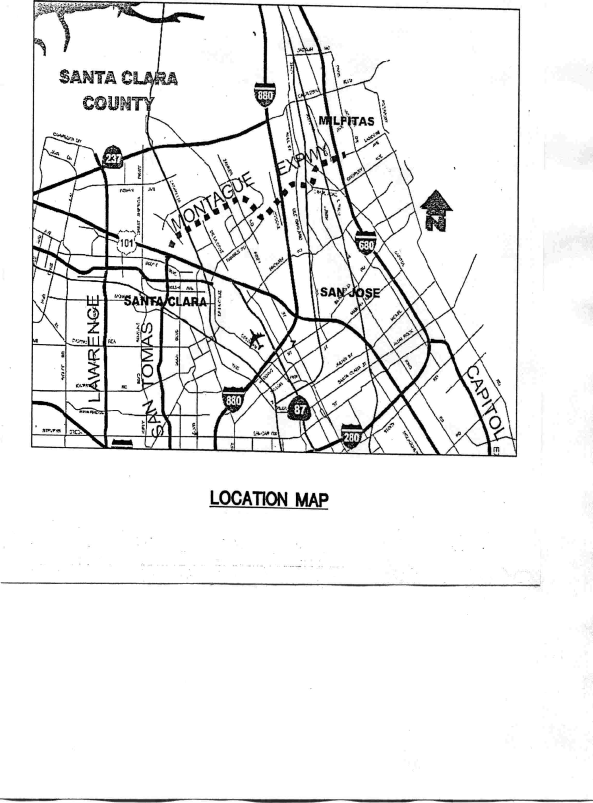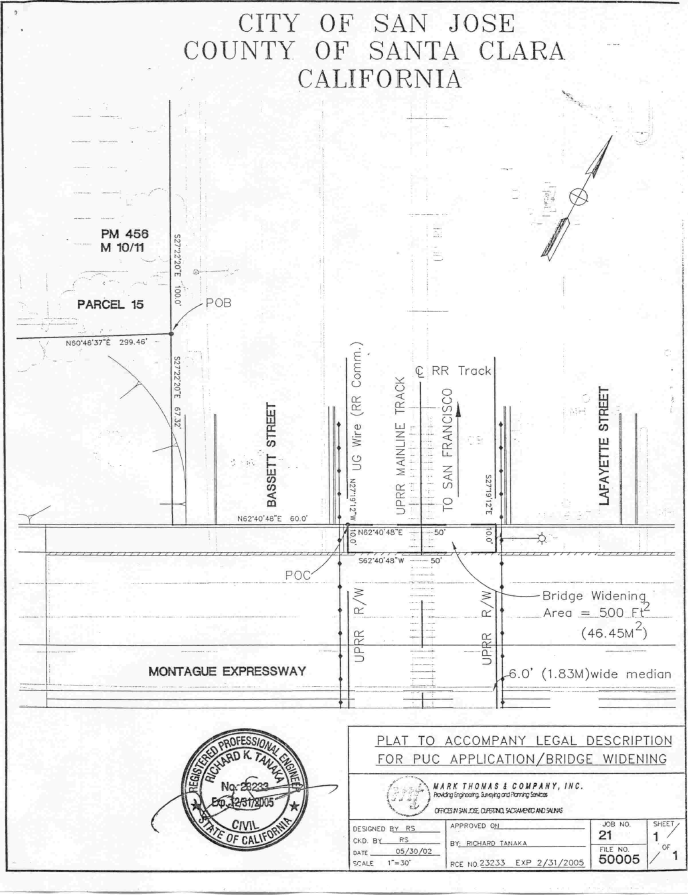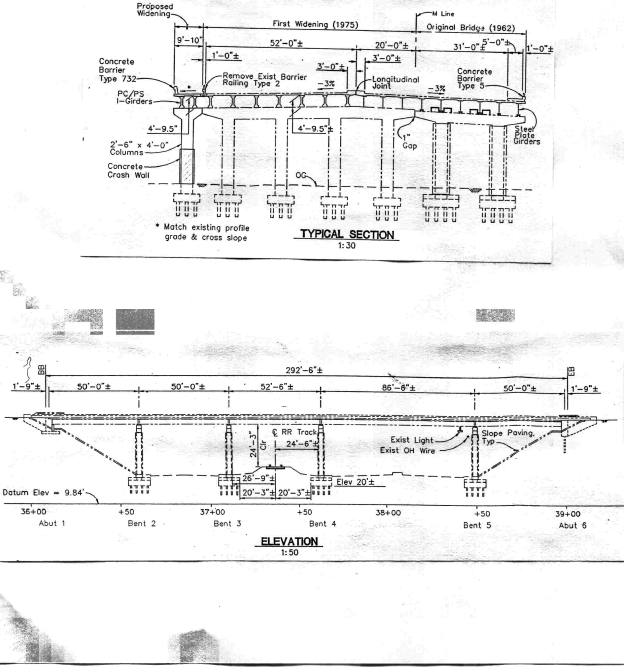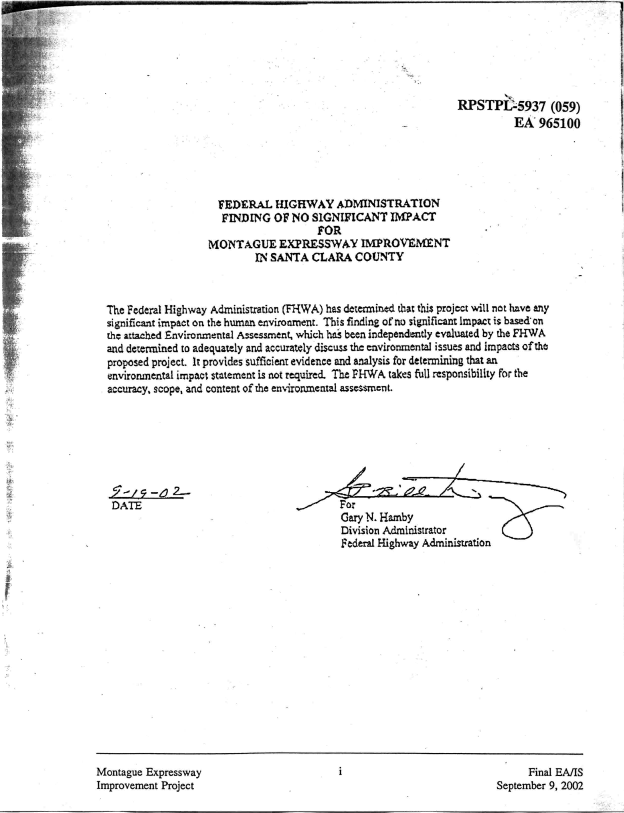Discussion
The proposed Project would expand Montague Expressway from the current three lanes in each direction to four travel lanes. The Project limits are from U.S. 101 to the west and to Interstate 680 to the east. The primary purpose of the proposed Project is to relieve existing congestion and accommodate future traffic demand for traffic traveling in the Corridor. Existing Average Automobile Daily Traffic (AADT) on Montague Expressway is 81,000 with six lanes and has
sections currently operating at a Level of Service (LOS) "F" (LOS is a measure of driving conditions and delays, and ranges from "A" for best to "F" for poorest). In 2015, AADT for the Corridor is proposed to increase to 150,000. Currently, eight of the 16 signalized intersections operate at an LOS of "F." Under the No-Project scenario, in 2025 the number of LOS "F" intersections is projected to increase to 12 and 13 in the morning and afternoon peak hours, respectively. Total vehicle-hours-traveled would be less under post-project conditions, as compared to no project conditions, since overall capacity will be increased.
The grade-separated highway-rail crossing (CPUC Crossing No. 001L-42.1-A) is a five-span structure and is the only railroad structure to be widened in this Project. Two at-grade crossings also exist within the Project, but will be the subject of separate application(s). The widening of the grade-separated highway-rail crossing consists of widening the existing structure using a precast prestress structure, with no falsework required. The project proposes to widen the structure from six lanes to eight lanes. During peak hours, two of the eight lanes will be operated as commuter lanes, also known as High-Occupancy-Vehicle or HOV lanes.
The County is the lead agency for this project under the California Environmental Quality Act of 1970 (CEQA), as amended, Public Resources Code 21000 et seq. On September 19, 2002, in compliance with CEQA, the County filed its Notice of Determination with the Federal Highway Administration, approving this project stating that with mitigation, the project will not have a significant effect on the environment (State Clearinghouse Number 2001092076). Accordingly, the County adopted mitigation measures as a condition of approval of the project.
The Commission is a responsible agency for this project under CEQA (Public Resources Code Section 21000 et seq.). CEQA requires that the Commission consider the environmental consequences of a project that is subject to its discretionary approval. In particular, to comply with CEQA, a responsible agency must consider the lead agency's Environmental Impact Report or Negative Declaration prior to acting upon or approving the project (CEQA Guideline Section 15050(b)). The specific activities that must be conducted by a responsible agency are contained in CEQA Guideline Section 15096.
The Commission has reviewed the California Department of Transportation's (Caltrans) environmental documentation and finds the documents adequate for our decision-making purposes. The environmental documentation consists of an Initial Study/Finding of No Significant Impact (IS), and the Notice of Determination. Analysis of potential environmental impacts included: land use, hazardous materials, visual and aesthetics, water quality, transportation and traffic, geology, cultural resources, vegetation and wildlife, farm lands, floodplains, noise and air quality.
Safety and security, transportation and noise are within the scope of the Commission's permitting process. The environmental documentation did not identify any potential impacts related to safety and security.
Noise impacts were identified in the IS related to increased traffic noise and short-term noise due to construction. The mitigation measures adopted to address these impacts will: a) reduce traffic noise by installing a series of soundwalls at various locations of the Project, with the heights being determined by the physical characteristics of each specific location. The soundwalls will be constructed as a first task, as to provide noise reduction during the Project, b) pile driving will be limited to the hours of 8 a.m. to 5 p.m. Monday through Friday, c) near sensitive receptors, and where practical, construction operations will be restricted to daytime hours of 7 a.m. to 7 p.m., with no construction on Sundays or holidays, d) equipment will be maintained in good mechanical condition, and outfitted with the appropriate noise suppression devices, e) staging of construction equipment and unnecessary idling will be avoided near sensitive receptors whenever feasible, f) temporary walls/barriers/enclosures will be erected around stationary equipment when such equipment will be operated for a period of time (i.e., 2-3 days) near sensitive receptors and g) advanced notification will be given to residents within 300 feet alerting them of planned construction activities.
Transportation and traffic impacts were identified in the IS related to the loss of parking at seven locations, reduced LOS from "D" to "E" during the morning peak at the Montague/River Oaks/Plumeria intersection and a loss of driveway access to several businesses along Montague.
Mitigation for the loss of parking includes the following measures: a) on-site replacement parking will be provided, b) property/business owners will be provided with financial compensation for the loss of parking and c) in some cases, a combination of these two measures will be implemented. The threshold for reduced LOS to a point of significant impact is defined as the intersection reaching an LOS of "F." This is not the case for the intersection of Montague/River Oaks/Plumeria therefore no mitigation is needed. Mitigation for the loss of driveway access is to provide replacement access at each location to adjacent streets (Barber Lane, O'Toole Avenue, Junction Road and the southern loop road near O'Toole Avenue).
The Commission's Consumer Protection and Safety Division (CPSD), Rail Crossings Engineering Section (RCES) inspected the site of the proposed project.
After reviewing the need for and safety of the widening of the existing grade-separated highway-rail crossing, RCES recommends that the requested authority sought by County be granted for a period of two years.
With respect to the potentially significant noise and transportation impacts identified above, the Commission finds that the County adopted feasible mitigation measures to either eliminate or substantially lessen those impacts. Therefore, we similarly adopt and require the mitigations identified in the County's IS, for purposes of our project approval.
Application 02-07-006 meets the filing requirements of the Commission's Rules of Practice and Procedure, including Rule 38, which relates to the construction of a public highway across a railroad.
In Resolution ALJ 176-3091 dated July 18, 2002, the Commission preliminarily categorized this application as ratesetting, and preliminarily determined that hearings were not necessary. No protests have been received. The Commission's CPSD recommends that this application be granted. Given these developments, a public hearing is not necessary, and it is not necessary to disturb the preliminary determinations made in Resolution ALJ 176-3091.
This is an uncontested matter in which the decision grants the relief requested. Accordingly, pursuant to Public Utilities Code Section 311(g)(2), the otherwise applicable 30-day period for public review and comment is being waived.
Assignment of Proceeding
Richard Clark is the assigned Examiner in this proceeding.
1. Notice of the application was published in the Commission Daily Calendar on July 9, 2002. No protests have been filed.
2. County requests authority, under Public Utilities Code Sections 1201-1205, to widen the grade-separated highway-rail crossing over the tracks and right of way of the UP and Bassett and Lafayette Streets, which is identified as PUC Crossing No. 001L-42.1-A.
3. Public convenience, safety, and necessity require the widening of the Lafayette Street Overhead.
4. County is the lead agency for this project under CEQA, as amended.
5. The Commission is a responsible agency for this project, and has reviewed and considered the County's environmental documentation upon which the County relied in adopting mitigation measures for the project.
6. On December 10, 2002, the County filed its Notice of Determination approving the project and found that with mitigation measures, the Lafayette Street Overhead would not have a significant effect on the environment.
7. County's environmental documents are adequate for our decision-making purposes.
8. Safety and security, transportation and noise are within the scope of the Commission's permitting process.
9. The County's environmental documents did not identify any potential environmental impacts from the project related to safety or security.
10. The Commission finds that for each potentially significant impact related to transportation or noise, Caltrans adopted feasible mitigation measures to either eliminate or substantially lessen those impacts.
1. The application is uncontested and a public hearing is not necessary.
2. We adopt and require the mitigations identified in the County's IS for purposes of our project approval.
3. The application should be granted as set forth in the following order.
IT IS ORDERED that:
1. The County of Santa Clara Roads and Airport Department (County) is authorized to widen the Lafayette Street Overhead over the tracks and right of way of the Union Pacific Railroad Company (UP) and Lafayette and Bassett Streets, which is identified as Public Utilities Commission (PUC) Crossing No. 001L-42.1-A.
2. Clearances shall be in accordance with General Order (GO) 26-D.
3. Walkways shall conform to GO 118. Walkways adjacent to any trackage subject to rail operations shall be maintained free of obstructions and shall be promptly restored to their original condition in the event of damage during construction.
4. Prior to construction, County shall file with Consumer Protection and Safety Division's Rail Crossings Engineering Section (RCES) final construction plans, approved by UP.
5. Within 30 days after completion of the work under this order, County shall notify RCES in writing, by submitting a completed standard Commission Form G (Report of Changes at Highway Grade Crossings and Separations), that the authorized work is completed.
6. This authorization shall expire if not exercised within three years unless time is extended or if the above conditions are not complied with. Authorization may be revoked or modified if public convenience, necessity, or safety so require.
7. This application is granted as set forth above.
8. Application 02-07-006 is closed.
This order is effective today.
Dated May 8, 2003, at San Francisco, California.
MICHAEL R. PEEVEY
President
CARL W. WOOD
LORETTA M. LYNCH
GEOFFREY F. BROWN
SUSAN P. KENNEDY
Commissioners
